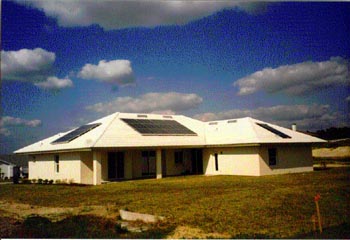
![]()
Original Project
Progress Report:
A Building Integrated PV System for New Residential
Applications in Florida: A Model Zero Energy Home
Sandia National Laboratories/
Florida Energy Office/Lakeland Electric & Water

A new project is under way to test the feasibility of designing and testing very efficient new residential buildings with integrated photovoltaic (PV) generation systems to meet cooling system and other electrical loads in a hot humid climate.
Objectives
The central objective of the project would be to test the feasibility of constructing new single family residences which are engineered to reduce air conditioning loads to an absolute minimum so that most of the cooling and other daytime electrical needs can be accomplished by the PV component. The project objectives would be:
- To design and construct a new residential building designed to minimize cooling and other electrical loads in a hot-humid climate. Concept: "Minimum cooling energy building"
- To engineer and integrate a PV electrical generation system into the home to produce most of its daytime electrical needs.
- To use the building's thermal capacitance to shift as much of the space cooling load as possible to the daytime hours. Question: Is it possible to produce a home which exerts no net impact on the grid during the utility coincident peak period?
- To compare the PV building's performance to a "control site" construction home which does not have either the PV component or the efficiency improvements.
- To collect comprehensive energy use and PV performance data from both project buildings for later analysis and to display the comparative real time performance of the two sites on the Internet for access by other researchers.
- To analyze the comparative performance of the two buildings in both an unoccupied and occupied state to demonstrate the validity of the concept.
Background
Previous work sponsored by the Florida Energy Office has simulated the possibility of greatly reducing the cooling loads in a conventional new home and then supplying most the cooling needs with a grid connected 3 kW PV array [1]. The results showed that the cooling system of a small 1,500 ft2 home might be reduced to as low as to be served by an air conditioner with a capacity as little as a single ton (12,000 Btu) capacity. The home would feature a group of efficiency measures and high efficiency cooling equipment and appliances (natural gas used for normally resistance end-uses). A 3 kW PV array would provide much of the electricity needed to power such a building.
The PV-integrated home would have the following elements designed to minimize cooling loads. The specific measures have been simulated in detail and measured in several field projects [2-7].
- White reflective roof
- Exterior insulation over concrete block system
- Well shaded or reflective double-glazed windows
- High efficiency refrigerator
- High efficiency compact fluorescent lighting
- SEER 15.0 variable speed 2.0-ton air conditioner
- Duct system within the conditioned space
- Ceiling fans in main zone and exterior lighting on dedicated motion sensors
- Landscape shading
- Programmable thermostat
Work Tasks
As part of the project, FSEC would work with a builder in the vicinity of Lakeland, Florida to monitor two homes which are under construction. One of the houses would be of standard construction with typical appliances, insulation and standard equipment. The experimental home would contain the efficiency improvements and the PV element. Both would be extensively monitored. Specific work tasks would include:
- Locate builder for building the PV-integrated and control home in the Lakeland area.
- Work with builder to obtain necessary materials and equipment to complete construction.
- Configure and install system PV system.
- Set up detailed data acquisition systems and set up project data retrieval.
- Set up Internet site with real time display of comparative data from the two sites.
- Monitor data from two buildings during summer conditions in an unoccupied state.
- Continue monitoring for a full year under occupied conditions.
- Experiment with control strategies of system to provide optimum performance.
- Analyze data to assess comparative performance and proof of concept.
Other Progress Report Updates
References
1. Parker, D.S. and Dunlop, J.P., 1994. "Solar Photovoltaic Air Conditioning of Residential Buildings," Proceedings of the 1994 Summer Study on Energy Efficiency in Buildings, Vol. 3, p. 188, American Council for an Energy Efficient Economy, Washington D.C.
2. Parker, D., Fairey, P., Gueymard, C., McCluney, R., McIlvaine, J. and Stedman, T., 1992. Rebuilding for Efficiency: Improving the Energy Use of Reconstructed Residences in South Florida, FSEC-CR-562-92, Florida Solar Energy Center, Cocoa, FL.
3. "The Surprising Potential of Programmable Thermostats" and "Comprehensive Residential Retrofit Project," BDAC Energy Files, Vol. 3, No. 2, Building Design Assistance Center at the Florida Solar Energy Center, Cocoa. FL.
4. Parker, D., Barkaszi, S.F., Jr, Sherwin, J.R. and Richardson, C.S., 1996. "Central Air Conditioner Usage Patterns in a Hot Humid Climate: Influences on Energy Use and Peak Demand," Proceedings of the 1996 Summer Study on Energy Efficiency in Buildings, American Council for an Energy Efficient Economy, Vol. 8, p. 147, Washington D.C.
5. Parker, D.S., Barkaszi, S.F., Chandra, S. and Beal, D.J., 1995. "Measured Cooling Energy Savings from Reflective Roofing System in Florida," Proceedings of the Thermal Performance of the Exterior Envelopes of Buildings VI, DOE/ASHRAE, Clearwater, FL.
6. Ternes, M., Parker, D., and Barkaszi, S.F., 1996. "Modeled and Metered Energy Savings from Exterior Wall Insulation," Proceedings of the 1996 Summer Study on Energy Efficiency in Buildings, American Council for an Energy Efficient Economy, Vol. 10, Washington D.C.
7. Parker, D. and Schrum, L., 1996. Results from a Comprehensive Residential Lighting Retrofit, FSEC-CR-914-96, Florida Solar Energy Center, Cocoa, FL.
